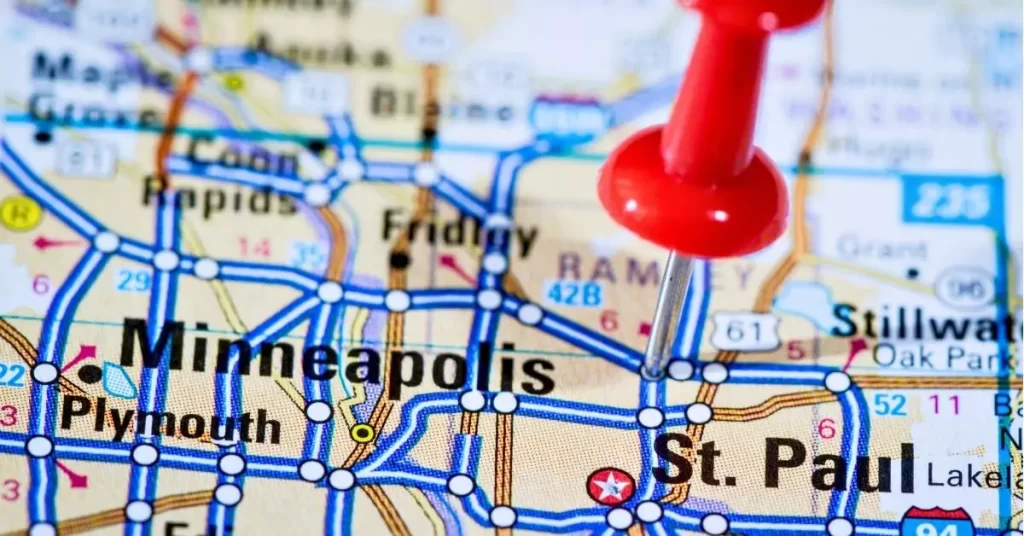
Located in the state of Minnesota, Minneapolis and St. Paul are two cities that share a unique bond, earning them the nickname “Twin Cities.”
But have you ever wondered how they came to be known by this moniker? Let’s jump into the history and development of these two cities and uncover the reasons behind their “twin” identity.
A Brief History
Minneapolis and St. Paul have a rich history dating back to the 17th century when French explorers first settled along the Mississippi River. The two cities are situated on opposite banks of the river, with Minneapolis on the west and St. Paul on the east. This proximity played a significant role in their development and eventual nickname.
In 1680, French explorer Daniel Greysolon, Sieur du Lhut, became the first European to visit the area. He named the region “Mni Sota Makoce,” which means “Land Where the Waters Reflect the Sky” in the Dakota language. Over time, the name evolved into “Minnesota.”
Early Development
In the mid-19th century, Minneapolis began to grow rapidly, driven by the lumber and flour milling industries. The city’s location on the west bank of the Mississippi River made it an ideal spot for transportation and trade.
The construction of the Saint Anthony Falls dam in 1848 further boosted the city’s growth, providing power for the flour mills and sawmills.
St. Paul, on the other hand, developed more slowly, initially serving as the capital of Minnesota. The city’s location on the east bank of the Mississippi River made it a strategic spot for trade and commerce. With the arrival of the railroad in 1849, St. Paul’s growth accelerated, and it became a major commercial center.
Shared Features
So, what makes Minneapolis and St. Paul “twins”? Here are some key features they share:
| Feature | Minneapolis | St. Paul |
|---|---|---|
| Location | West bank of the Mississippi River | East bank of the Mississippi River |
| Industry | Lumber and flour milling | Commercial center and government hub |
| Population | Approximately 430,000 | Approximately 307,000 |
| Cultural attractions | Walker Art Center, Minneapolis Sculpture Garden | Science Museum of Minnesota, Cathedral of Saint Paul |
| Sports teams | Minnesota Twins (baseball), Minnesota Vikings (football) | Minnesota Wild (hockey) |
| Education | University of Minnesota | University of St. Thomas, Hamline University |
Cultural Significance
The Twin Cities’ nickname reflects not only their geographical proximity but also their cultural and economic interconnectedness. Both cities have a thriving arts scene, with numerous museums, theaters, and music venues. They also share a love for outdoor activities, with numerous parks and lakes in the surrounding area.
The Twin Cities are home to several festivals and events throughout the year, including the Minneapolis Sculpture Garden’s Summer Concert Series and the St. Paul Winter Carnival.
The cities also have a strong tradition of community and social activism, with many organizations and initiatives focused on issues like education, healthcare, and environmental sustainability.
Economic Ties
Minneapolis and St. Paul have a long history of economic cooperation, with many businesses and organizations operating in both cities.
The Twin Cities are home to several major corporations, including 3M, Ecolab, and Land O’Lakes. The region is also a hub for healthcare and medical research, with the University of Minnesota and the Mayo Clinic having a significant presence.
Conclusion
In conclusion, Minneapolis and St. Paul are called the Twin Cities due to their shared history, geographical location, and cultural similarities.
From their early days as French settlements to their current status as thriving metropolitan areas, these two cities have been inextricably linked. Whether you’re interested in history, culture, outdoor activities, or economic development, the Twin Cities have something to offer.
FAQs
Why are Minneapolis and St. Paul called the Twin Cities?
Minneapolis and St. Paul are called the Twin Cities because of their close proximity, parallel growth, and shared history.
They are situated just 10 miles apart in Minnesota’s Hennepin and Ramsey counties, and they have invested in shared infrastructure to enhance connectivity. Both cities also boast a range of amenities that are shared by their residents, such as world-class museums and a vibrant art scene.
What are the historical developments and milestones in the Twin Cities?
The story of the Twin Cities begins with early settlements along the Mississippi River. In the mid-19th century, pioneers recognized the strategic location of these towns, leading to their rapid growth.
The construction of mills and industries attracted people from various parts of the United States, fueling expansion. One significant milestone was the establishment of St. Paul as Minnesota’s capital city in 1858.
What are the factors that contribute to the economic prosperity of the Twin Cities?
The economic success enjoyed by both cities can be attributed to several key factors, including diverse industries, an education hub, a collaborative culture, and a high quality of life.
The Twin Cities area boasts a diverse range of industries, including healthcare, finance, technology, and manufacturing. This diversity has provided stability and contributed to sustained economic growth.
What are the cultural and economic contributions of the Twin Cities?
Minneapolis and St. Paul have nurtured a thriving arts community that contributes significantly to their unique identity. The abundance of museums, galleries, theaters, and music venues makes it evident why the Twin Cities are renowned for their cultural offerings.
The Walker Art Center stands as a testament to Minneapolis’ commitment to the arts, while the Minnesota History Center showcases the rich heritage of the region.
For more information on other aspects of Minneapolis, check out our articles on:
